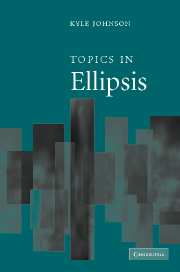Book contents
- Frontmatter
- Contents
- 1 Introduction
- 2 VP Ellipsis and constraints on interpretation
- 3 Direct compositionality and variable-free semantics: the case of Antecedent Contained Deletion
- 4 The view of QR from ellipsis
- 5 Argument Contained Ellipsis
- 6 Variable island repair under ellipsis
- 7 On binding scope and ellipsis scope
- 8 The silent content of bound variable pronouns
- 9 A step-by-step guide to ellipsis resolution
- 10 Shared constituents and Linearization
- Notes
- References
- Index
2 - VP Ellipsis and constraints on interpretation
Published online by Cambridge University Press: 22 September 2009
- Frontmatter
- Contents
- 1 Introduction
- 2 VP Ellipsis and constraints on interpretation
- 3 Direct compositionality and variable-free semantics: the case of Antecedent Contained Deletion
- 4 The view of QR from ellipsis
- 5 Argument Contained Ellipsis
- 6 Variable island repair under ellipsis
- 7 On binding scope and ellipsis scope
- 8 The silent content of bound variable pronouns
- 9 A step-by-step guide to ellipsis resolution
- 10 Shared constituents and Linearization
- Notes
- References
- Index
Summary
Introduction
Beginning with early work such as Ross (1967) and Sag (1976), the interpretation of ellipsis has been an enduring preoccupation of linguistics research. Many researchers have attempted to use ellipsis as a tool to gain insight into otherwise hidden structures and mechanisms underlying interpretation. According to Sag's account of VP Ellipsis (VPE), the facts of ellipsis reflect logical aspects of the representation of pronouns, which are ambiguous between a lambda-bound and referential reading. On this influential view, ellipsis reveals an intricate machinery of lambda binding, pronoun indexing, and scope relations.
Subsequent research has shed doubt on this pleasing picture – it has been shown that ellipsis interpretation is more flexible than Sag's theory permits, and this has lead to the proposal of numerous alternative theories. In Hardt (1993), I proposed that VPE resolution be completely free, at least with respect to pronoun interpretation. This makes it possible to represent pronouns in a uniform way, without indexing or ambiguity. If VPE resolution is indeed free in this sense, then any constraints that appear to arise in ellipsis must instead be imposed by more general mechanisms.
Perhaps ellipsis is revealing in a rather different sense than suggested by Sag: instead of providing insight into the intricacies of the logical form of sentences, ellipsis emerges as a window onto the general mechanisms governing the interpretation of multi-sentence discourse.
- Type
- Chapter
- Information
- Topics in Ellipsis , pp. 15 - 29Publisher: Cambridge University PressPrint publication year: 2008



